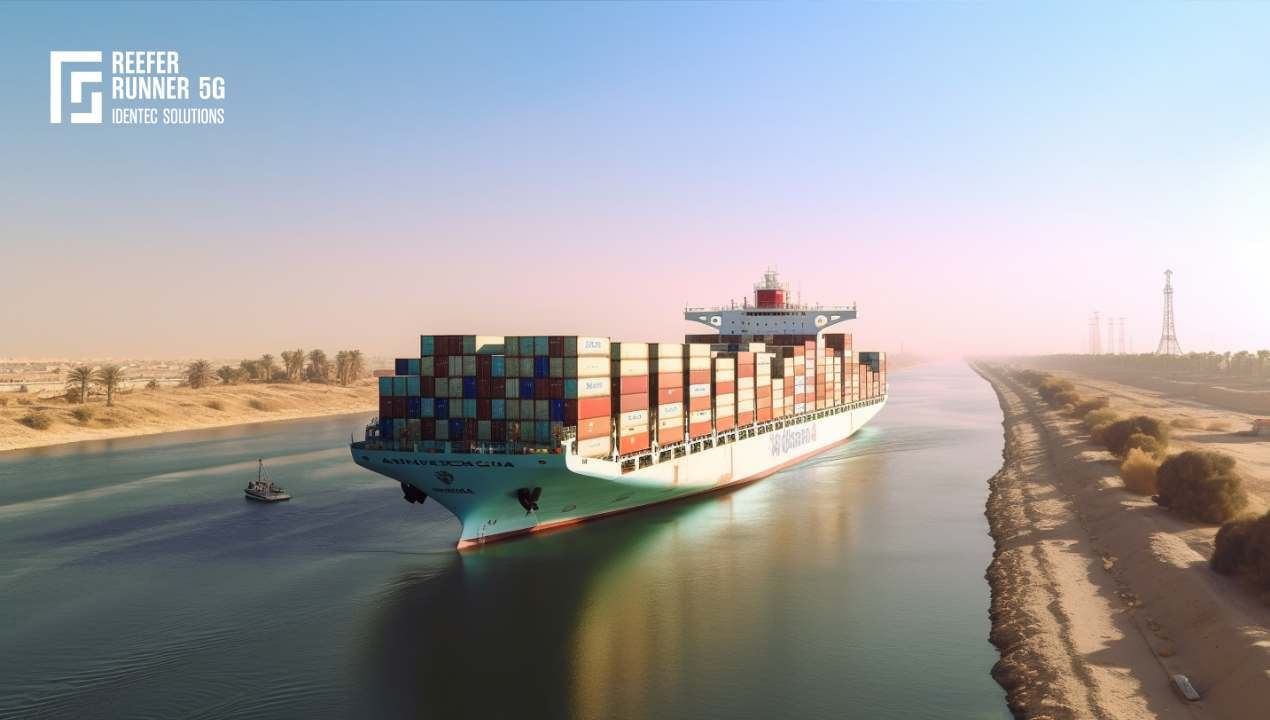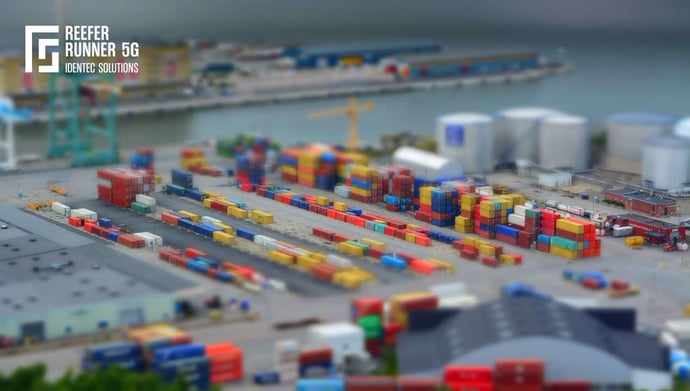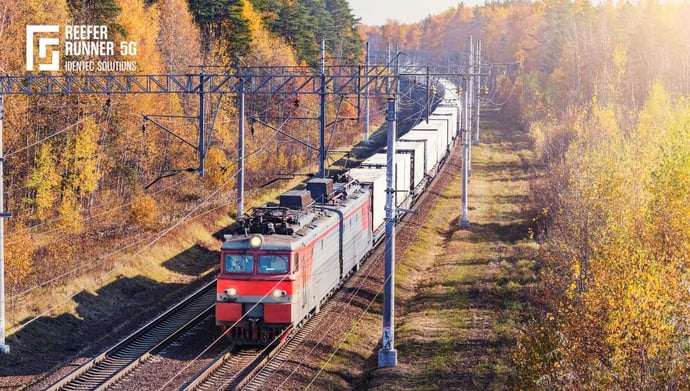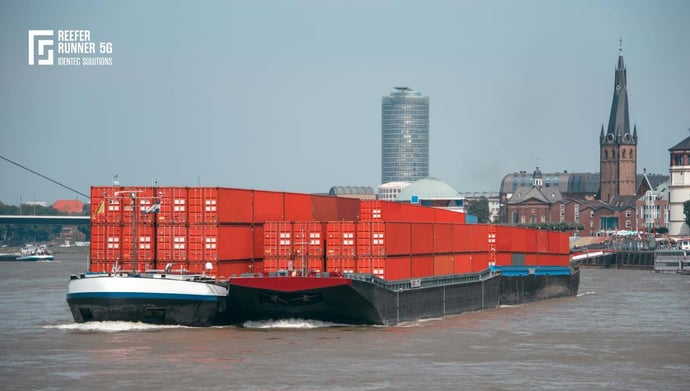Reefer Freight Unmasked: Cutting Through the Cold Chain Conundrum
| Written by Mark Buzinkay

No video selected
Select a video type in the sidebar.
reefer Freight: A Mouldy Surprise
With great anticipation, the reefer was opened at its destination in China; instead of a neatly stacked cargo of aluminium foil destined for chocolate packaging, a foul smell wafted from the interior. It was a nauseating mixture of stale air and earthy musk, a scent any freighter would dread – mould. What should have been pristine cardboard boxes of aluminium foil were instead splotched and discoloured with the unmistakable signs of mould growth.
Cristina, a seasoned exporter, was taken aback. For years, her company had been successfully exporting aluminium foil as reefer freight from Europe to China. Each box was carefully packed and conditioned within strict parameters: a temperature of 20±2°C, humidity levels at 50±5% rH, and ventilation of 6-8 air changes per hour (ACH). Yet, the last year had seen this ghastly occurrence repeated several times.
The implications of such a discovery were far from trivial. Beyond the immediate financial losses from the spoiled cargo, there was potential harm to Cristina's company's reputation. The feedback from the receiving company was dreaded, possibly laden with demands for explanations and, even worse, claims for compensation.
Perplexed and anxious to rectify the situation, Cristina and her team started to look for clues. The data loggers in the reefers, used to record temperature, humidity, and ventilation data, showed that the moisture inside the container had started to rise after crossing the Suez Canal.
Despite this valuable insight, more was needed to paint the complete picture. For that, they needed something else - the Reefer Controller Trip data. These valuable logs would provide a full picture of the reefer's conditions throughout the journey, including any changes made to the settings. However, obtaining this information would prove more challenging than expected, opening a window into an industry-wide problem of withheld information, obscured accountability, and a search for transparency.
Understanding the Enemy: What is Mould?
Mould is a fungus that is omnipresent in our environment, thriving in warm, damp conditions. It propagates through tiny, lightweight spores that float through the air. Under the right circumstances, these spores land and grow, feeding on organic material like wood, cardboard, and even certain types of metal coatings (1).
On a microscopic level, mould is a voracious beast, breaking down substances at a cellular level to fuel its growth. When it comes to cargo like the aluminium foil that Cristina was shipping, mould spells disaster. It can degrade packaging materials, penetrate goods, and render them unusable.
But the damage doesn't stop there. Mould can have profound health implications. Certain moulds produce mycotoxins, poisonous substances that can lead to health issues like respiratory problems, skin inflammation, and in severe cases, neurological damage. Such health risks mean that any product associated with mould is immediately considered compromised, often leading to entire cargo consignments being rejected.
To combat this enemy, cargo companies take extensive measures. They control environmental conditions, maintain sanitation, and monitor for the earliest signs of mould. Despite these efforts, the mould in Cristina's reefers highlighted that something was not working as it should.
Cristina knew she had to delve deeper into the potential causes. Was there a malfunction in the reefer's control systems? Was there a lapse in handling procedures of her reefer freight? Or was there something else amiss? With the evidence from the data loggers in hand, she hoped to unravel the mystery. Little did she know that the root cause of the mould infestation was a much bigger issue than she anticipated.
Learn more about proper cold chain storage technology.

What Are the Reasons for Mould?
Although mould is an omnipresent fungus, it only becomes a problem under certain conditions, especially in the confined environment of a reefer. The issue boils down to two significant factors - temperature and humidity. In Cristina's case, while the temperature inside the reefer was well within the range to prevent mould growth, the humidity posed a problem (see more about cold chain requirements).
Humidity issues within reefers can arise due to several reasons, including:
- Improper Loading: If cargo is not loaded correctly, gaps or spaces between packages can create pockets of humid air. This stagnant, moist air provides the perfect breeding ground for mould.
- Faulty Insulation: Good insulation is vital in maintaining temperature and preventing condensation, which can increase humidity levels. If the insulation is defective, these conditions fluctuate, potentially leading to high humidity and, subsequently, mould growth.
- High Ambient Temperature: If the temperature outside the container is high, it can increase the humidity level inside, especially if the container is not equipped with a dehumidifier.
- Inadequate Ventilation: Without proper ventilation, the air inside the container can become stagnant, leading to high humidity levels.
- Mechanical Failure: Failures in the refrigeration unit, like a malfunctioning fan or compressor, can lead to temperature fluctuations and condensation, subsequently causing high humidity.
Cristina's data loggers had shown a rise in humidity after the reefer freight passed the Suez Canal, which indicated that one or more of these factors might be in play. But to pinpoint the exact cause, she needed a more comprehensive dataset - the Reefer Controller Trip data, which could provide granular details on every aspect of the reefer's journey, including any changes made to its settings.
With this in mind, she reached out to the forwarders to request this crucial data. It was a logical step to ensure transparency and help resolve the recurring problem. However, what she received in response was far from expected.
Reefer freight: Data Logging and Its Limitations
The data logger was Cristina's silent observer during the journeys. These devices, placed strategically inside the reefer, continuously recorded the conditions inside, creating a timeline of temperature, humidity, and ventilation data. This data provided valuable insights, helping Cristina to spot the problem - a spike in humidity levels after crossing the Suez Canal.
Despite its usefulness, a data logger has its limitations. It only provides a partial snapshot of the situation, revealing what is happening inside the container but not why it is happening.
In Cristina's case, while the data logger clearly showed a surge in humidity, it could not answer the critical question: Was the ventilation system not working correctly? Did the reefer's insulation fail? Or was there a mechanical failure in the refrigeration unit?
To answer these questions, Cristina needed the Reefer Controller Trip data. This data, recorded by the reefer's in-built control system, can provide a much more detailed record of the journey, including any changes made to the settings on the reefer itself. It offers insights into how the reefer was functioning during the trip, thereby complementing the data from the logger.
This controller trip data is invaluable in diagnosing and resolving issues like the one Cristina faced. It was the missing piece of the puzzle, the key to understanding what went wrong and how to prevent it in future shipments.
A Wall of Silence: Forwarders Refuse to Share Protocols
Faced with the recurring mould issue, Cristina sought to understand the problem by asking for the Reefer Controller Trip data from the forwarders. These documents, typically recorded by the reefer's in-built control system, could give Cristina a clearer picture of the entire journey - from Croatia to China - and possibly pinpoint the cause of the surge in humidity that led to the mould.
However, the response she received was far from what she expected. The forwarders refused to share the protocols, claiming that it was their "internal data" and could not be released to the customer. This response was disheartening and frustrating for Cristina, who was trying to solve a problem that had disrupted her business for months.
Forwarders are intermediaries in the shipping industry, bridging the gap between shippers like Cristina and the shipping lines that operate the vessels. Their role is crucial, and they are responsible for providing clear and accurate information about the shipments they handle.
However, in this case, Cristina faced an opaque wall. The forwarders' refusal to share the protocols was a clear abdication of their responsibility. It highlighted a significant gap in the industry, where shippers are often left in the dark about critical aspects of their shipments.
This lack of transparency in cold chain shipping not only hinders problem-solving but also erodes trust in the shipping process. It underscores the need for changes in industry practices to ensure that shippers have access to all necessary data about their shipments.
The Power of Reefer Controller Trip Data: A Call for Transparency
While the data logger provided Cristina with essential insights into the reefer's internal conditions, the Reefer Controller Trip data would offer a comprehensive view of the reefer's operation and handling throughout the journey. This data could reveal if the settings on the reefer were changed at any point, possibly to save energy, which might have inadvertently led to the rise in humidity and subsequent mould growth.
The forwarders' refusal to provide this data laid bare a significant gap in the industry's transparency and accountability standards. As external reefer freight experts advised, Cristina needed to insist on receiving the Reefer Controller Trip data with every shipment.
Given the recent developments in IoT and smart technologies, it is more feasible than ever for shipping companies to provide shippers with real-time data on their cargo's condition and handling. These smart reefers, as they are called, can provide a wealth of data about temperature, humidity, and even the reefer's power status throughout the journey.
However, forwarders are still falling short in making use of these technologies to provide better services to their customers. Cristina was told that her reefer did not have a chip, implying it was not a smart reefer and, therefore, could not provide the trip data. This excuse highlighted a lack of transparency and a potential reluctance to upgrade and use new technologies for better service delivery.
As an industry, we need to move towards greater transparency, more efficient use of technology, and better communication between forwarders and shippers. It is high time that the Reefer Controller Trip data becomes a standard part of the shipping package to prevent shippers like Cristina from being left in the dark, grappling with issues that could quickly be resolved with better data access.
(delve deeper into the topic of river barges and cold chain logistics)
The Path Forward: Real-Time Monitoring and Requesting reefer freight Data
To avoid costly and frustrating predicaments like the one Cristina faced, it's crucial to implement real-time monitoring of your shipments. Today's technology allows for constant oversight of reefer conditions, granting shippers immediate insights into any potential issues during transit.
However, real-time monitoring is just one piece of the puzzle. Alongside it, as part of every shipping agreement, shippers should demand access to the Reefer Controller Trip data. This detailed data not only complements the real-time monitoring but offers an overarching view of the reefer's performance and any alterations made during the shipment. With this data in hand, shippers can engage in informed discussions with forwarders, targeting precise issues rather than fumbling in the dark.
As the experience of Cristina suggests, some forwarders may be hesitant to provide this data, arguing it is "internal" or citing outdated equipment as an excuse. Here, persistence is key. Do not let a wall of silence or a barrage of excuses prevent you from gaining the insight you need to ensure your shipments arrive in the best condition possible.
In our rapidly digitizing world, access to comprehensive data is no longer a luxury but a necessity for efficient and reliable freight transportation. The industry needs to move past the "standard" practices and embrace "smart" solutions that deliver not only goods but also transparency, accountability, and peace of mind to shippers around the globe.
A Tale of Caution and Insight: The Takeaway
Cristina's experience is a stark reminder of the challenges that shippers face in today's complex and often opaque reefer freight industry. It illuminates the necessity for transparency, communication, and the use of technology in maintaining the quality of sensitive goods during long-haul shipments.
The mould issue that surfaced was not just an isolated case of bad luck; it was a symptom of a larger systemic problem within the freight forwarding industry - a lack of transparency and accountability. Shippers like Cristina, who invest significant resources into maintaining their goods, deserve complete visibility into their shipments (see also: Cold chain components).
Shippers need to insist on real-time monitoring of their goods and access to Reefer Controller Trip data, which can provide invaluable insights into the conditions of the shipment throughout its journey. Despite the hesitancy or resistance from forwarders, standing firm in these demands is crucial.
Moreover, while modern technologies provide us with more advanced ways of monitoring, it is still essential to review all factors - from packaging, loading, insulation, and ambient temperatures to ventilation and mechanical functions of reefers - when issues arise. Comprehensive analysis and insight can help identify problems and drive solutions, ensuring that sensitive reefer freight reaches its destination in optimum condition (read also about cold chain warehouse management).
Ultimately, Cristina's experience serves as a poignant lesson for the freight industry. It calls for a greater shift towards transparency, use of technology, and collaboration. It's about time we move towards a future where shippers don't have to fight for data - instead, they're provided with all the necessary information proactively, helping to ensure that their precious cargo arrives just as intended, no matter how far it travels.
Dive deeper into one of our core topics: Cold Chain Monitoring
Glossary
Insulation refers to materials or methods used to reduce heat, sound, or electrical transfer between environments. Thermal insulation minimizes heat exchange, improving energy efficiency in buildings and equipment. Acoustic insulation reduces noise transmission, enhancing comfort in spaces. Electrical insulation prevents the flow of electricity, ensuring safety in electrical systems. Common materials include fiberglass, foam, and rubber. Proper insulation is essential for energy conservation, safety, and comfort in various applications.(2)
Sources:
(1) S. Janssen, I. Pankoke, K. Klus, K. Schmitt, U. Stephan and J. Wöllenstein: Two underestimated threats in food transportation: mould and acceleration. Published: 13 June 2014 https://doi.org/10.1098/rsta.2013.0312
(2) Turner, W. C., et al. Energy Management Handbook. Fairmont Press, 2020.
Note: This article was updated on the 22nd of January 2025

Author
Mark Buzinkay, Head of Marketing
Mark Buzinkay holds a PhD in Virtual Anthropology, a Master in Business Administration (Telecommunications Mgmt), a Master of Science in Information Management and a Master of Arts in History, Sociology and Philosophy. Mark spent most of his professional career developing and creating business ideas - from a marketing, organisational and process point of view. He is fascinated by the digital transformation of industries, especially manufacturing and logistics. Mark writes mainly about Industry 4.0, maritime logistics, process and change management, innovations onshore and offshore, and the digital transformation in general.
Related Articles
Related Product





